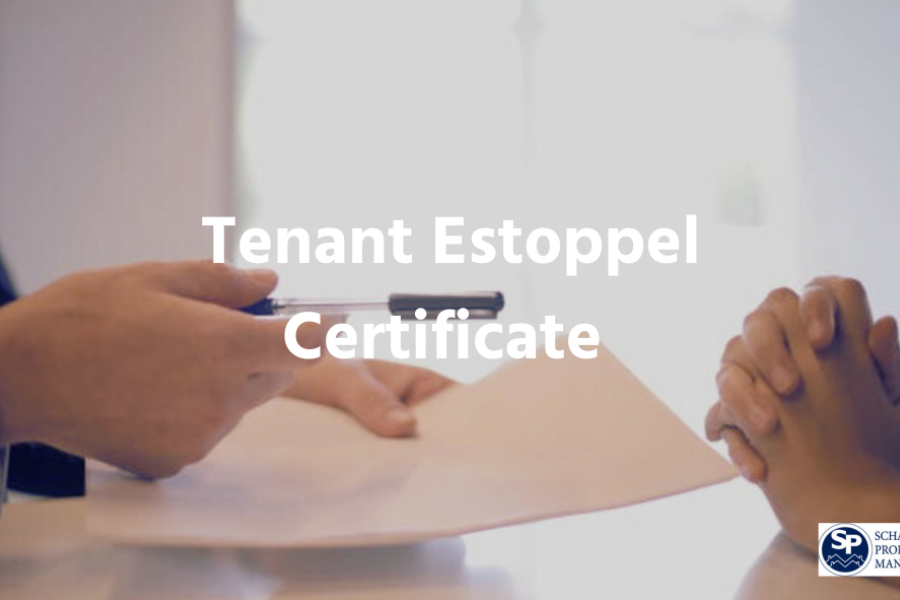
Key Takeaways
- A tenant estoppel certificate verifies lease terms and protects against disputes during a sale or refinancing.
- Including an estoppel clause in leases ensures tenants must provide the certificate when requested.
- Accuracy and timeliness are critical—errors or delays can jeopardize a transaction.
- Keeping signed certificates on file provides long-term value for future sales, refinances, or disputes.
When a commercial or residential property is being sold or refinanced, one of the most important documents involved in the process is the tenant estoppel certificate.
Many landlords, especially those new to property management, may not be fully aware of its purpose or significance. However, failing to understand or properly handle this document can lead to serious financial and legal complications.
In simple terms, a tenant estoppel certificate is a statement signed by a tenant that verifies the terms and status of their lease agreement.
This document is often requested by potential buyers or lenders to confirm that the lease is in good standing.
Schambs Property Management put together this article to help landlords understand what a tenant estoppel certificate is, why it matters, and how to manage it correctly.
Understanding Tenant Estoppel Certificates
What Is a Tenant Estoppel Certificate?
A tenant estoppel certificate is a document signed by a tenant that verifies the current terms and status of their lease.
This includes key information such as the lease start and end dates, the rent amount, security deposit, and whether the landlord has fulfilled their obligations. The certificate confirms that the tenant’s understanding of the lease matches what the landlord has represented.
Why Buyers and Lenders Request Estoppel Certificates
When a property is being sold or refinanced, buyers and lenders want to verify the income potential of the property.
Estoppel certificates serve as proof that leases are valid, enforceable, and free from disputes. This provides reassurance that the new owner or lender will not face unexpected challenges related to tenant agreements.
Common Details Included in the Certificate
Typical items in a tenant estoppel certificate include:
- Tenant’s name and unit number
- Lease start and end dates
- Monthly rent amount and due date
- Security deposit amount
- Status of rent payments (current or overdue)
- Existence of any defaults by either party
- Any agreements not included in the written lease
These details allow third parties to confirm the tenant’s lease terms and compliance.
The Importance of Lease Clauses Requiring Estoppel Certificates
Not all leases automatically require tenants to provide estoppel certificates. Without this clause, tenants may refuse to sign one when requested. To avoid this issue, landlords should include a clear provision in every lease stating that tenants must complete and return an estoppel certificate upon request, typically within a specified time frame.
Timing and Deadlines Matter
Estoppel certificates are usually requested during the due diligence phase of a sale or refinancing. This period often comes with strict deadlines, and delays can threaten the entire transaction. Landlords must act promptly and work closely with tenants to ensure that certificates are completed and returned on time.
Risks of Inaccurate or Incomplete Certificates
Mistakes in tenant estoppel certificates can lead to legal or financial problems. Reviewing each certificate for accuracy is crucial before submitting them to third parties.
Handling Complaints and Disputes in the Process
Sometimes, tenants use estoppel certificates to raise unrelated complaints or disputes. While the certificate is not intended for this purpose, such comments can raise concerns with buyers or lenders.
Landlords should proactively resolve issues with tenants before requesting estoppel certificates to prevent these situations.
Streamlining the Process with Draft Templates
To simplify the process, landlords can provide tenants with a pre-filled draft certificate based on lease records. Tenants can then review and confirm the information. While tenants can suggest corrections if necessary, providing a draft helps ensure consistency and reduces the risk of errors.
Multi-Tenant Properties Require Extra Coordination
In commercial or multi-unit residential properties, landlords may be asked to obtain estoppel certificates from multiple tenants.
Buyers and lenders often require a percentage of tenant responses before approving a transaction. Managing this process efficiently requires good communication and recordkeeping.
Recordkeeping and Long-Term Value
Once signed, estoppel certificates should be kept on file. They are useful documents that verify lease terms and may be referenced in future disputes or financial matters. Keeping them organized can save time and avoid confusion down the line.
Bottom Line
A tenant estoppel certificate is not just another piece of paperwork. It plays a critical role in the sale or refinancing of a rental property. It protects the interests of all parties involved by confirming the key terms of the lease and reducing the chances of future disputes.
Landlords who understand how to use these certificates properly will be better prepared for successful transactions and better tenant relations.
Schambs Property Management has years of experience handling tenant estoppel certificates for landlords across a wide range of properties.
Our team ensures that lease documents are accurate, tenants are properly informed, and all estoppel certificates are completed and submitted correctly and on time.
If you are planning to sell or refinance your rental property, or just want to be better prepared, contact Schambs Property Management today for expert support.